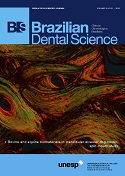Treatment of extensive cystic lesion in the maxilla associated with dens in dente
DOI:
https://doi.org/10.14295/bds.2016.v19i3.1269Resumo
Dens in dente is a dental development malformation that involves more commonly the upper lateral incisors. Infection of the canal of these teeth can cause the formation of chronic periapical lesions. The present study aimed to describe an integrated approach between the endodontic therapy and surgical intervention in an upper lateral incisor with dens in dente type II. A female patient, 14 years old, looked for dental care complaining of left palatal and paranasal bulging. Clinical, radiological and histopathological findings suggested periradicular cyst. First, marsupialization was performed to reduce the size of the lesion and to favor its enucleation, with less risk of injuring the tooth and vital structures. After diagnosis of pulp necrosis and in attempt to reduce the infection via canal, we used the reciprocating instrumentation associated with irrigation with sodium hypochlorite, intracanal medication based on calcium hydroxide and filled with a thermoplastic filling. After a year of marsupialization, fistulectomy and complete enucleation of the lesion were performed. Proservation was performed 1, 3, 6 and 12 months following marsupialization. Six months after enucleation, we observed the periradicular repair and remission of symptoms. The extensive apical lesion associated with dens in dente type II can be treated with a combination of surgical and endodontic therapy.
Downloads
Downloads
Arquivos adicionais
Publicado
Como Citar
Edição
Seção
Licença
TRANSFERÊNCIA DE DIREITOS AUTORAIS E DECLARAÇÃO DE RESPONSABILIDADE
Toda a propriedade de direitos autorais do artigo "____________________________________________________________________" é transferido do autor(es) para a CIÊNCIA ODONTOLÓGICA BRASILEIRA, no caso do trabalho ser publicado. O artigo não foi publicado em outro lugar e não foi submetido simultaneamente para publicação em outra revista.
Vimos por meio deste, atestar que trabalho é original e não apresenta dados manipulados, fraude ou plágio. Fizemos contribuição científica significativa para o estudo e estamos cientes dos dados apresentados e de acordo com a versão final do artigo. Assumimos total responsabilidade pelos aspectos éticos do estudo.
Este texto deve ser impresso e assinado por todos os autores. A versão digitalizada deverá ser apresentada como arquivo suplementar durante o processo de submissão.




























